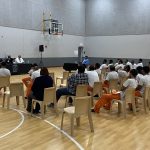Milwaukee’s Time of Terror
A new book recounts the police station bombing of 1917, and Clarence Darrow’s defense of the anarchists charged with the crime.
The central police station occupied the southeast corner of the intersection of Oneida (now Wells Street) and Broadway. An elaborate stone castle, the armory, adjoined it to the east. City Hall, a glorious Flemish Renaissance building housing the district court and the municipal court for criminal cases, stood one block west on Oneida and then a few strides north, its imposing stone arch opening south toward Oneida Street. The location was convenient, for the city jail occupied part of the second floor of the police station.
The night shift’s roll call was under way when the boys arrived. Mazzone approached the night stationkeeper, Desk Sergeant Henry Deckert, who sat behind a massive desk at the far end of the public entry way. From this redoubt, Deckert dealt with the walk-in traffic. Operator Spindler worked dispatch and the telephones upstairs. Mazzone tendered the package to Deckert. At the moment, Deckert was occupied with Catherine Walker, a single woman of thirty-six who was there to make a delicate complaint of extortion against a former boyfriend. When he turned his attention to Mazzone and the package, Deckert either knew what it was or had a strong hunch. But he had not seen one like this before.
Deckert told Mazzone to stay put, picked up the bomb, and took it to Lieutenant Flood, his supervisor, in Flood’s office adjoining the entrance hall to the south. Flood reacted decisively. “Get rid of the damned thing at once!” he barked.
Easier said than done. Where exactly would he go with it “at once”? Who would man the desk? No one suggested then to Deckert that he could dunk it in a pail of water, which might have been the best bet. Whatever his reasons, Deckert turned, crossed the hall to the north end of the station (the Oneida Street side), and carried the package into the squad room, also called the assembly room. Roll call now had concluded there, and patrolmen were straggling out to find peacoats, caps, and gear to begin their shifts. Upstairs, where the detectives had their separate roll call, Detective Henry Mangert had not yet reported, tardy for the first time in sixteen years.
Deckert deposited the suspected bomb on the large table in the squad room. Then he summoned the station house’s detectives, who had no beats to walk. Seven wandered down. Detective Bert Stout, however, left almost as soon as he arrived to answer a new call, about an attempted suicide, from the Pabst Theater, just more than a block west on Oneida Street.
Mazzone and his companion waited in the public reception area as Deckert had directed. Catherine Walker, though, ducked into the squad room herself momentarily to avoid an officer whom she knew, then entering the police station. Unmarried, she was embarrassed by her errand concerning the awkward situation with her former suitor. What would the officer and her fellow workers at the Otto Pietsch Dye Company think of her? Deckert stood closest to the table, possibly with his hands on the curious package, as the six detectives clustered about. No one paid any attention to Walker near the door. She peeked out, eager for a chance to leave unobserved. Plainclothesman Frank M. Caswin, the newest officer in the assembly room, lingered out of interest. Three to six minutes or more, give or take, had passed since Mazzone had walked in the door. The men peered.
Exactly then, the “infernal machine,” as newspapers of the day often called bombs, did its work.
Henry Mangert, tardy just this once, lived. Two other detectives, Louis Hartman and Herman Bergin, were in the building and badly hurt. But both escaped fatal injury. Detective Burns had left the squad room almost immediately to go to Lieutenant Flood’s office, there to suggest, sensibly but too late, immersing the bomb in a pail of water. He was unhurt. And, in a bit of irony, the attempted suicide at the Pabst Theater saved Stout’s life.
Ralph S. McPherran, the chief chemist at Allis-Chalmers, a vast manufacturer in neighboring West Allis, surmised later that the vial in the bomb held sulfuric acid, which dripped onto a zinc plate. That dripping generated heat. Eventually the heat ignited either cotton or black powder. McPherran considered it a very powerful bomb. Its maker had packed the container with screws, bolts, tacks, and other metal slugs to make it more lethal. The bomb stripped the assembly room walls of all plaster. One slug reportedly traveled a full city block, punched through a bedroom window, and still was hurtling fast enough to cut through an iron bed post.
Four people actually made it out of the blackened squad room only half-dead. In part, their brief reprieve was the work of Detective Bert Stout and Lieutenant Robert Flood, who tried furiously to rescue their colleagues. Seehawer, Spindler, and Walker died en route to Emergency Hospital in a “wildly clanging” ambulance. Stecker got to the operating table, but he was beyond help. The quiet gray ambulance from the morgue came again.
The next day, Sunday, Police Chief John T. Janssen sat in his office on the second floor, his building partly destroyed and in chaos as hundreds of the morbid gathered outside and poked through the rubble. Lieutenant Flood was nearby. With melodramatic effect, a reporter wrote that Janssen held a list of the dead and injured in his hand. At least five detectives had left young and middle-aged widows. “It is terrible,” Janssen intoned. “I sympathize with the families. Their grief is a thousand times keener than ours.” Flood, although hard-bitten and an old hand, just sobbed.

Dean Strang
Thanksgiving indeed was bleak. It was gray, dirty, and cold. Purifying snow would come, but not just yet. No greater number of American police officers had ever died together before. Nine were lost that night; Chicago’s Haymarket Square bombing on May 4, 1886, took but seven. No greater number would die together again until September 11, 2001.
The story is excerpted from the new book by Madison attorney, “Worse Than The Devil: Anarchists, Clarence Darrow And Justice In A Time of Terror.”
















“Milwaukee’s Germans, Poles, Italians, and Irish … mostly had drifted northward from Chicago in search of work.”
Really? I’ve never read anywhere that Milwaukee owed its population growth to Chicago drifters.
Did the author of the book also write the article about the book? Wow, journalistic ethics strike again.
@John… It is an excerpt from the book, which it says at the end of the post.
Good job to read the whole post there John…
So laziness not unethical. Got it.
Too lazy to read the entire article?